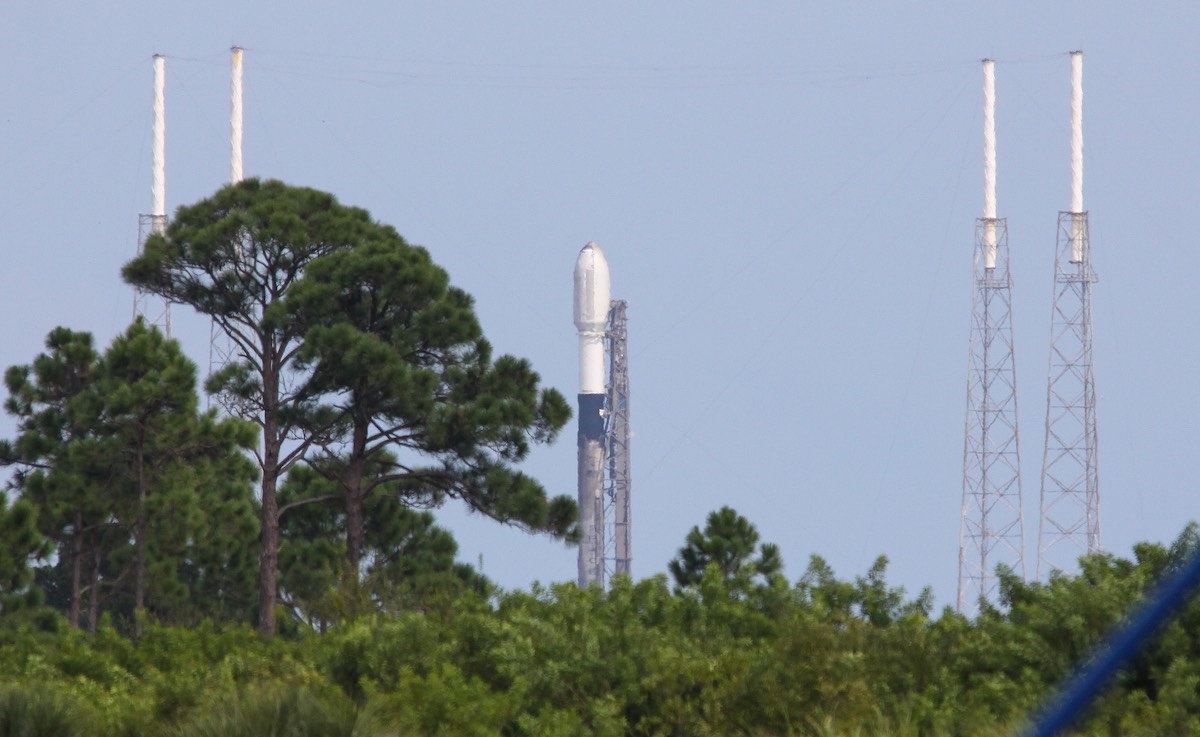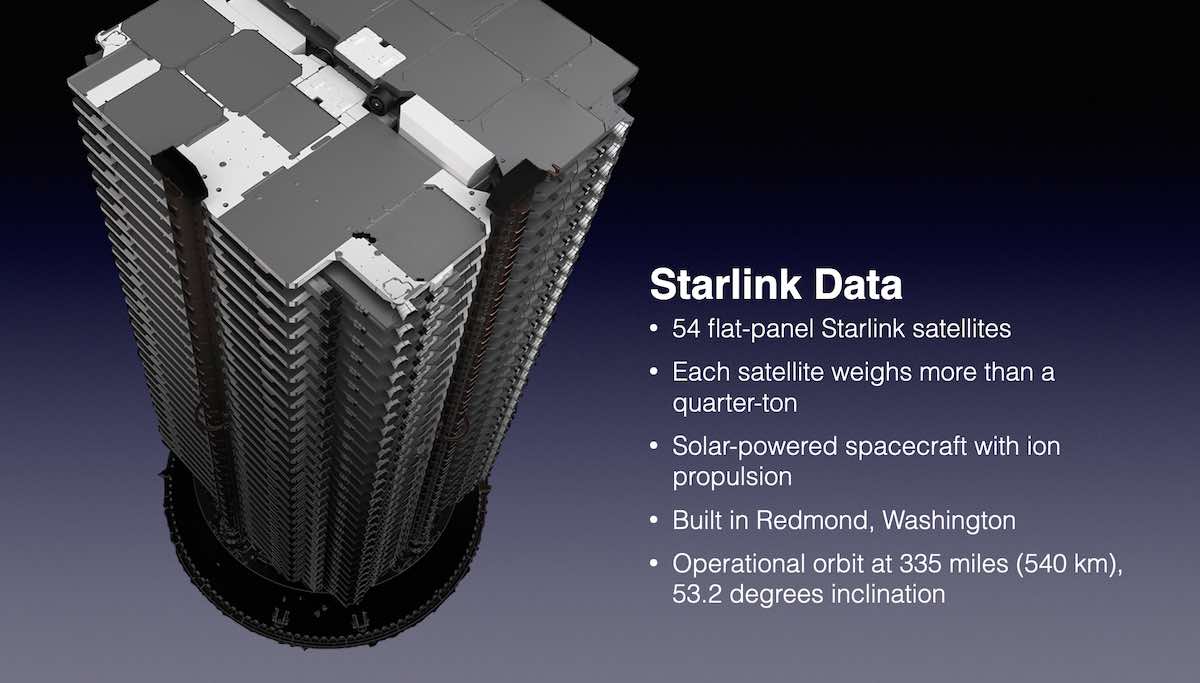Live coverage of the countdown and launch of a SpaceX Falcon 9 rocket from Space Launch Complex 40 at Cape Canaveral Space Force Station in Florida. The Starlink 4-34 mission will launch SpaceX’s next batch of 54 Starlink broadband satellites. Follow us on Twitter.
SFN Live
Continuing a push to launch more than 60 missions this year, SpaceX is gearing up for another flight of a Falcon 9 rocket Tuesday night to deliver 54 more Starlink internet satellites into orbit.
The 229-foot-tall (70-meter) Falcon 9 rocket is set for launch at 10:10:10 p.m. EDT Tuesday (0210:10 GMT Wednesday) from pad 40 at Cape Canaveral Space Force Station in Florida. The flight will mark SpaceX’s 42nd Falcon 9 launch so far in 2022. It will be the 40th space launch attempt overall from Florida’s Space Coast this year, including launches by SpaceX, United Launch Alliance, and Astra.
Weather will be iffy Tuesday night, with forecasters from the U.S. Space Force’s 45th Weather Squadron prediction 50-50 odds of acceptable conditions for liftoff. The weather team predicts scattered thunderstorms across Central Florida on Tuesday afternoon.
“While activity is expected to be winding down and moving offshore going into this evening’s launch window, convective debris and anvils from earlier activity will likely linger,” the forecast team wrote in the launch weather outlook Tuesday morning. “The main weather concerns will be the anvil cloud rules and the debris cloud rule with the leftover activity.”
The launch Tuesday, designated Starlink 4-34, will carry 54 more Starlink internet satellites into orbit. The Falcon 9’s upper stage will release the satellites over the North Atlantic Ocean about 15 minutes after liftoff. The 54 Starlink satellites will total about 36,800 pounds, or 16.7 metric tons, in payload mass.
The Starlink 4-34 mission will be the third of as many as six Falcon 9 missions on SpaceX’s schedule this month. Tom Ochinero, SpaceX’s vice president of commercial sales, said Tuesday at the World Satellite Business Week conference in Paris that the company aims to complete more than 60 launches this year, with the goal of 100 rocket missions in 2023, continuing a dramatic uptick in SpaceX’s launch cadence.
The higher launch date has been aided by shorter turnarounds between missions at launch pads in Florida and California, and SpaceX’s reuse of Falcon 9 boosters and payload fairings. Launches carrying satellites for SpaceX’s own Starlink internet network, like the mission Tuesday night, have accounted for about two-thirds of the company’s Falcon 9 flights so far this year.
SpaceX began flying 54 Starlink satellites on dedicated Falcon 9 flights last month, one more spacecraft than the company typically launched on previous missions. SpaceX has experimented with different engine throttle settings and other minor changes to stretch the Falcon 9’s performance.

SpaceX test-fired the Falcon 9 booster for the Starlink 4-34 mission at the launch pad Sunday morning. A static fire attempt Saturday afternoon was aborted as a strong thunderstorm swept across the Cape Canaveral spaceport.
The booster is designed B1067 in SpaceX’s inventory of reusable rockets, and is going for its sixth flight to space Tuesday night. The booster previously launched two astronaut missions toward the International Space Station, plus two resupply flights to the station. It also launched Turkey’s Turksat 5B communications satellite.
With the Starlink 4-34 mission Saturday night, SpaceX will have launched 3,347 Starlink internet satellites, including prototypes and test units no longer in service. The launch Saturday will be the 61st SpaceX mission primarily dedicated to hauling Starlink internet satellites into orbit.
Stationed inside a launch control center just south of Cape Canaveral Space Force Station, SpaceX’s launch team will begin loading super-chilled, densified kerosene and liquid oxygen propellants into the 229-foot-tall (70-meter) Falcon 9 vehicle at T-minus 35 minutes.
Helium pressurant will also flow into the rocket in the last half-hour of the countdown. In the final seven minutes before liftoff, the Falcon 9’s Merlin main engines will be thermally conditioned for flight through a procedure known as “chilldown.” The Falcon 9’s guidance and range safety system will also be configured for launch.
After liftoff, the Falcon 9 rocket will vector its 1.7 million pounds of thrust — produced by nine Merlin engines — to steer northeast over the Atlantic Ocean.
The rocket will exceed the speed of sound in about one minute, then shut down its nine main engines two-and-a-half minutes after liftoff. The booster stage will release from the Falcon 9’s upper stage, then fire pulses from cold gas control thrusters and extend titanium grid fins to help steer the vehicle back into the atmosphere.
Two braking burns will slow the rocket for landing on the drone ship “Just Read the Instructions” around 400 miles (650 kilometers) downrange approximately eight-and-a-half minutes after liftoff.

The Falcon 9’s reusable payload fairing will jettison durning the second stage burn. A recovery ship is also on station in the Atlantic to retrieve the two halves of the nose cone after they splash down under parachutes.
Landing of the first stage on Saturday’s mission will occur moments after the Falcon 9’s second stage engine cuts off to deliver the Starlink satellites into orbit. Separation of the 54 Starlink spacecraft, built by SpaceX in Redmond, Washington, from the Falcon 9 rocket is expected at T+plus 15 minutes, 21 seconds.
Retention rods will release from the Starlink payload stack, allowing the flat-packed satellites to fly free from the Falcon 9’s upper stage in orbit. The 54 spacecraft will unfurl solar arrays and run through automated activation steps, then use krypton-fueled ion engines to maneuver into their operational orbit.
The Falcon 9’s guidance computer aimed deploy the satellites into an elliptical orbit at an inclination of 53.2 degrees to the equator. The satellites will use on-board propulsion to do the rest of the work to reach a circular orbit 335 miles (540 kilometers) above Earth.
The Starlink satellites will fly in one of five orbital “shells” at different inclinations for SpaceX’s global internet network. After reaching their operational orbit, the satellites will enter commercial service and begin beaming broadband signals to consumers, who can purchase Starlink service and connect to the network with a SpaceX-supplied ground terminal.
ROCKET: Falcon 9 (B1067.6)
PAYLOAD: 54 Starlink satellites (Starlink 4-23)
LAUNCH SITE: SLC-40, Cape Canaveral Space Force Station, Florida
LAUNCH DATE: Sept. 13, 2022
LAUNCH TIME: 10:10:10 p.m. EDT (0210:10 GMT on Sept. 14)
WEATHER FORECAST: 50% chance of acceptable weather; Low risk of upper level winds; Low risk of unfavorable conditions for booster recovery
BOOSTER RECOVERY: “Just Read the Instructions” drone ship east of Charleston, South Carolina
LAUNCH AZIMUTH: Northeast
TARGET ORBIT: 144 miles by 208 miles (232 kilometers by 336 kilometers), 53.2 degrees inclination
LAUNCH TIMELINE:
- T+00:00: Liftoff
- T+01:12: Maximum aerodynamic pressure (Max-Q)
- T+02:27: First stage main engine cutoff (MECO)
- T+02:31: Stage separation
- T+02:36: Second stage engine ignition
- T+02:42: Fairing jettison
- T+06:48: First stage entry burn ignition (three engines)
- T+07:07: First stage entry burn cutoff
- T+08:26: First stage landing burn ignition (one engine)
- T+08:40: Second stage engine cutoff (SECO 1)
- T+08:47: First stage landing
- T+15:21: Starlink satellite separation
MISSION STATS:
- 176th launch of a Falcon 9 rocket since 2010
- 184th launch of Falcon rocket family since 2006
- 6th launch of Falcon 9 booster B1067
- 151st Falcon 9 launch from Florida’s Space Coast
- 97th Falcon 9 launch from pad 40
- 152nd launch overall from pad 40
- 118th flight of a reused Falcon 9 booster
- 61st dedicated Falcon 9 launch with Starlink satellites
- 42nd Falcon 9 launch of 2022
- 42nd launch by SpaceX in 2022
- 40th orbital launch attempt based out of Cape Canaveral in 2022
Email the author.
Follow Stephen Clark on Twitter: @StephenClark1.
from Spaceflight Now https://ift.tt/ybZ5mkM
via World Space Info







0 comments:
Post a Comment